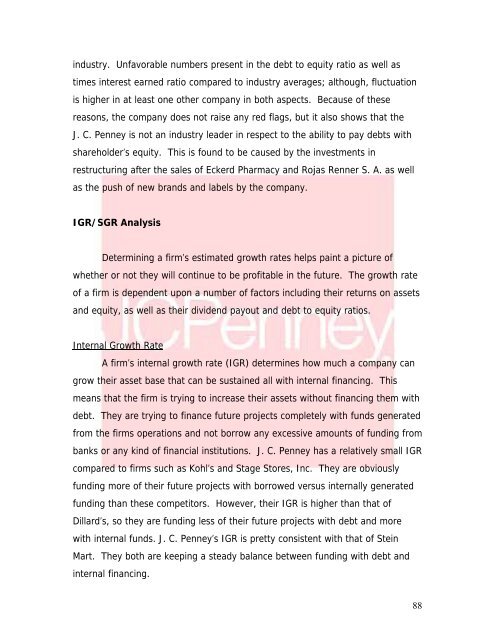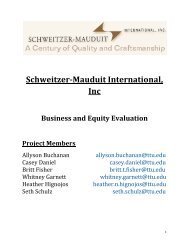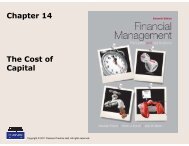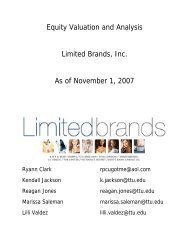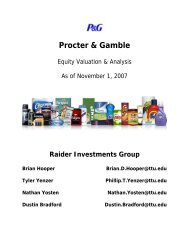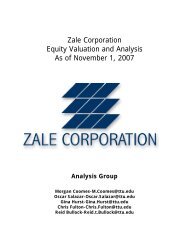J. C. Penney Company, Inc. Equity Valuation and Analysis As of ...
J. C. Penney Company, Inc. Equity Valuation and Analysis As of ...
J. C. Penney Company, Inc. Equity Valuation and Analysis As of ...
You also want an ePaper? Increase the reach of your titles
YUMPU automatically turns print PDFs into web optimized ePapers that Google loves.
industry. Unfavorable numbers present in the debt to equity ratio as well astimes interest earned ratio compared to industry averages; although, fluctuationis higher in at least one other company in both aspects. Because <strong>of</strong> thesereasons, the company does not raise any red flags, but it also shows that theJ. C. <strong>Penney</strong> is not an industry leader in respect to the ability to pay debts withshareholder’s equity. This is found to be caused by the investments inrestructuring after the sales <strong>of</strong> Eckerd Pharmacy <strong>and</strong> Rojas Renner S. A. as wellas the push <strong>of</strong> new br<strong>and</strong>s <strong>and</strong> labels by the company.IGR/SGR <strong>Analysis</strong>Determining a firm’s estimated growth rates helps paint a picture <strong>of</strong>whether or not they will continue to be pr<strong>of</strong>itable in the future. The growth rate<strong>of</strong> a firm is dependent upon a number <strong>of</strong> factors including their returns on assets<strong>and</strong> equity, as well as their dividend payout <strong>and</strong> debt to equity ratios.Internal Growth RateA firm’s internal growth rate (IGR) determines how much a company cangrow their asset base that can be sustained all with internal financing. Thismeans that the firm is trying to increase their assets without financing them withdebt. They are trying to finance future projects completely with funds generatedfrom the firms operations <strong>and</strong> not borrow any excessive amounts <strong>of</strong> funding frombanks or any kind <strong>of</strong> financial institutions. J. C. <strong>Penney</strong> has a relatively small IGRcompared to firms such as Kohl’s <strong>and</strong> Stage Stores, <strong>Inc</strong>. They are obviouslyfunding more <strong>of</strong> their future projects with borrowed versus internally generatedfunding than these competitors. However, their IGR is higher than that <strong>of</strong>Dillard’s, so they are funding less <strong>of</strong> their future projects with debt <strong>and</strong> morewith internal funds. J. C. <strong>Penney</strong>’s IGR is pretty consistent with that <strong>of</strong> SteinMart. They both are keeping a steady balance between funding with debt <strong>and</strong>internal financing.88


